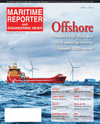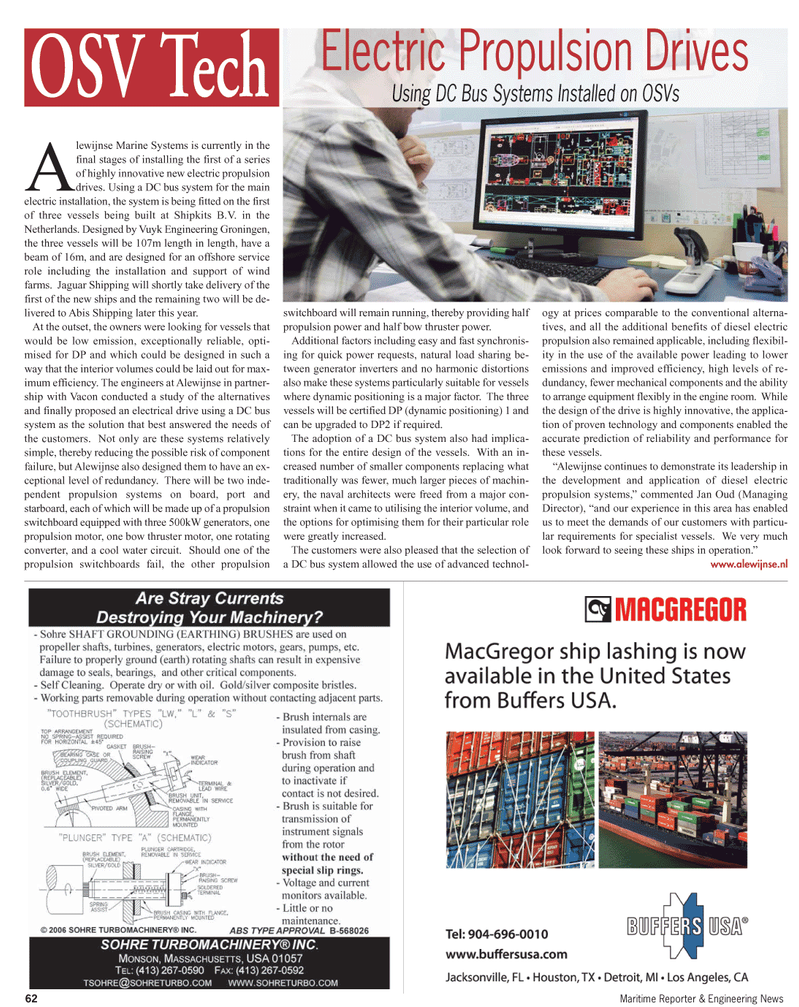
Page 66: of Maritime Reporter Magazine (April 2012)
Offshore Deepwater Annual
Read this page in Pdf, Flash or Html5 edition of April 2012 Maritime Reporter Magazine
Alewijnse Marine Systems is currently in the final stages of installing the first of a series of highly innovative new electric propulsion drives. Using a DC bus system for the main electric installation, the system is being fitted on the first of three vessels being built at Shipkits B.V. in the Netherlands. Designed by Vuyk Engineering Groningen, the three vessels will be 107m length in length, have a beam of 16m, and are designed for an offshore service role including the installation and support of windfarms. Jaguar Shipping will shortly take delivery of the first of the new ships and the remaining two will be de- livered to Abis Shipping later this year. At the outset, the owners were looking for vessels that would be low emission, exceptionally reliable, opti- mised for DP and which could be designed in such away that the interior volumes could be laid out for max- imum efficiency. The engineers at Alewijnse in partner- ship with Vacon conducted a study of the alternatives and finally proposed an electrical drive using a DC bus system as the solution that best answered the needs ofthe customers. Not only are these systems relatively simple, thereby reducing the possible risk of componentfailure, but Alewijnse also designed them to have an ex- ceptional level of redundancy. There will be two inde- pendent propulsion systems on board, port andstarboard, each of which will be made up of a propulsionswitchboard equipped with three 500kW generators, onepropulsion motor, one bow thruster motor, one rotating converter, and a cool water circuit. Should one of the propulsion switchboards fail, the other propulsion switchboard will remain running, thereby providing half propulsion power and half bow thruster power. Additional factors including easy and fast synchronis- ing for quick power requests, natural load sharing be- tween generator inverters and no harmonic distortions also make these systems particularly suitable for vessels where dynamic positioning is a major factor. The three vessels will be certified DP (dynamic positioning) 1 and can be upgraded to DP2 if required.The adoption of a DC bus system also had implica- tions for the entire design of the vessels. With an in- creased number of smaller components replacing whattraditionally was fewer, much larger pieces of machin- ery, the naval architects were freed from a major con- straint when it came to utilising the interior volume, and the options for optimising them for their particular rolewere greatly increased.The customers were also pleased that the selection ofa DC bus system allowed the use of advanced technol- ogy at prices comparable to the conventional alterna- tives, and all the additional benefits of diesel electric propulsion also remained applicable, including flexibil- ity in the use of the available power leading to lower emissions and improved efficiency, high levels of re- dundancy, fewer mechanical components and the ability to arrange equipment flexibly in the engine room. While the design of the drive is highly innovative, the applica- tion of proven technology and components enabled the accurate prediction of reliability and performance forthese vessels. Alewijnse continues to demonstrate its leadership in the development and application of diesel electric propulsion systems,? commented Jan Oud (Managing Director), and our experience in this area has enabled us to meet the demands of our customers with particu- lar requirements for specialist vessels. We very much look forward to seeing these ships in operation.? www.alewijnse.nl 62Maritime Reporter & Engineering News OSV Tech Electric Propulsion Drives Using DC Bus Systems Installed on OSVs

 65
65

 67
67
